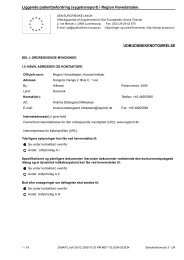Territorial Review Copenhagen - Region Hovedstaden
Territorial Review Copenhagen - Region Hovedstaden
Territorial Review Copenhagen - Region Hovedstaden
Create successful ePaper yourself
Turn your PDF publications into a flip-book with our unique Google optimized e-Paper software.
71<br />
the countries that attract the most high-skilled immigrants, such as the<br />
United States, United Kingdom, Canada, Ireland, Mexico, Luxembourg,<br />
Switzerland and Australia. As mentioned above, Denmark has a large<br />
disparity in the unemployment rates of immigrants relative to the nativeborn<br />
population (twice as high). The relatively limited importance of<br />
<strong>Copenhagen</strong> as a hub for highly skilled workers is illustrated by its ranking<br />
by the number of international offices of the leading 15 global executive<br />
search firms. In 2005, <strong>Copenhagen</strong> was ranked 11 th among European cities;<br />
and similar-sized northern European cities such as Amsterdam and<br />
Stockholm ranked higher (Faulconbridge and Hall, 2008).<br />
Studies suggest that high taxation and a relatively closed business<br />
culture may be deterrents to highly skilled foreigners. A recent study<br />
concludes that taxation plays an important role in determining where Danish<br />
migrants go and where migrants to Denmark come from (Nielson, 2007).<br />
Another factor that helps attract highly skilled labour is the possibility of<br />
career advancement. Since <strong>Copenhagen</strong> has a relatively small number of<br />
large internationally oriented companies, fewer career possibilities exist for<br />
internationally oriented foreign workers. Moreover, the corporate world in<br />
Denmark has been observed to exhibit ―small world characteristics‖: a<br />
network of directors of firms closely connected through board affiliation<br />
(Sinani et al., 2008). A study of highly skilled foreign labour found that a<br />
third of the foreign workers in the survey considered that Danes were not<br />
particularly open or accommodating towards them, both in the private and<br />
professional contexts (Oxford Research, 2007).<br />
While there are so far no indications of a brain drain, recent trends give<br />
reason for concern. According to recent studies, the outflow of highly<br />
skilled Danes is balanced by a comparable influx of highly skilled foreigners<br />
(Socialforskningsinstituttet, 2007), and 70% of highly skilled Danes who<br />
leave the country come back within five years (Globalization Committee,<br />
2006). However, the number of Danish temporary workers in the United<br />
States is approaching the total amount of work permits that Denmark gives<br />
out annually. 23 There are indications that more Danish students going abroad<br />
stay abroad, and migration of Danish PhDs is increasing (Villesen, 2008).<br />
Recurring survey results show that approximately 10% of PhDs leave the<br />
country to work abroad within 18 months of earning their degree. PhDs in<br />
natural sciences head the list, with a mobility rate of around 18%. It appears<br />
that PhDs employed abroad return to Denmark after a number of years; on<br />
average only 50% return after five years abroad (OECD, 2005).<br />
Numbers for <strong>Copenhagen</strong> seem to indicate a small net inflow of<br />
foreigners, although it is not clear whether this presents a brain gain. Over<br />
2000-07, 12 570 foreigners per year on average came directly to the city of<br />
<strong>Copenhagen</strong> (and Frederiksberg); in the same period, around 11 775 people

















